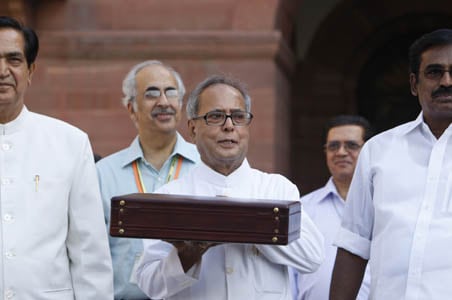
Presenting his first budget in 25 years, Finance Minister Pranab Mukherjee on Monday raised the allocation under the National Rural Employment Guarantee Scheme to over Rs 39,000 crore, increased the planned spend for the Bharat Nirman programme by nearly 50 per cent and gave a Rs 12,000 crore boost to the rural roads programme called the Pradhan Mantri Gram Sadak Yojana.
Another Rs 1,000 crore have been promised for programmes for the development of irrigation. Farmers have also been promised interest subvention on short-term crop loans, while families below poverty line are to get 25 kg rice every month at subsidised prices.
In addition to these largesse, another Rs 7,000 crore for the Rajiv Rural Electrification Scheme and Rs 8,800 crore for the Indira Awaas Yojana -- a rural housing programme -- has also been promised by the Finance Minister.
The first budget of the UPA government's second term also gives more money in the hands of taxpayers, hoping increased consumption will drive demand and help restore growth to levels seen two years ago.
The planned expenditure will mean the government will have to borrow $3.9 lakh crore for the current financial year ending March 2010 -- the highest ever in India's history. Finance Minister said that he hoped to contain fiscal deficit at 6.8 per cent of the GDP. Mukherjee did not give a timeline by when the government would put its fiscal house in order. He merely stated that the government would return to the Fiscal Responsibility and Budget Management (FRBM) target as soon as possible.
"This is a budget that focuses on growth in rural India," Prime Minister Manmohan Singh told Doordarshan.
India's 30-stock Sensex lost over 5.5 per cent after the budget announcement. Since May 17, when the UPA government was voted to power, Sensex had outpaced regional markets with a 22 per cent gain.
"The budget lacks in three areas: It does not talk about governance; it does not talk about accountability and it does not mention the reform process," YM Deosthalee, CFO L&T said.
"Since this is the first policy statement that the new government is making, we had expected more," Ajit Gulabchand, chairman Hindustan Construction Company told NDTV.
Industry had expected the Finance Minister to announce an increase in FDI cap in the insurance sector to 49 per cent from 26 per cent at present, a cut in corporate tax, increased tax exemption on interest paid on housing loans, or a bailout package for the airline sector. Industry had also expected an aggressive disinvestment programme, which would help bridge the gap between government revenue and expenditure.
Mukherjee said in his budget speech that the government expected to raise Rs 1,120 crore through sale of shares in government companies.
The good news for India Inc came as the Finance Minister announced the abolition of Fringe Benefit Tax (FBT), a tax on perquisites, which had been introduced by former Finance Minister P Chidambaram three years ago. Industry had spoken in one voice seeking the removal of FBT and Mukherjee gave in to their demand. However, he raised the Minimum Alternate Tax (MAT) for corporates to 15 per cent from 10 per cent, which did not go down well with the large corporates.
As Mukherjee was preparing his budget, the question before him was: What to choose between higher growth and higher fiscal deficit? While the details of spending were announced by the government, there was little to share with the industry or markets about its plans to shore up its finances. The auction of spectrum for 3G telecom services is expected to generate Rs 35,000 crore for the government.
"We do not need a budget to announce everything," Union Minister of Surface Transport and Highways Kamal Nath told NDTV.
With enhanced spending in rural areas, the government hopes to give a fresh fillip to the consumption story from rural India. Nearly 70 per cent of India's 1.2 billion people live in villages and agriculture contributes about 21 per cent to India's $1.3 trillion economy.
There are already some indications that rural demand is going strong. India's largest two-wheeler manufacturer Hero Honda has traditionally seen 30 per cent of its sales in rural and semi-urban India. In the last few months, with demand from cities going down, rural sales now accounts for nearly 50 per cent of its sales.
"We would like to see renewed focus on rural areas and that has come about," Sunil Munjal, MD Hero Honda said.
With the record borrowing plan, there could be further pressure on interest rates.
"You have to loosen the regulation if you want some of the funds to come in," Koushik Chaterjee, Group CFO Tata Steel said.
While corporates were cautious in their criticism of the Union Budget, individuals had much to cheer, with a small hike in the minimum threshold limit for tax payable, while the bigger benefit came from the scrapping of the 10 per cent surcharge on the tax. Senior citizens earning up to Rs 2.4 lakh a year will now be exempted from tax. For other taxpayers, there will be no tax on earnings up to Rs 1.6 lakh a year -- up Rs 10,000 compared to last year.
The budget has come less than eight weeks after the UPA government, led by the Congress party, received unexpected support from rural India to govern India for a second term. Pranab Mukherjee played a little to the galleries and clearly tried to address the constituency that has helped the UPA return to power for a second-term.
Track Latest News Live on NDTV.com and get news updates from India and around the world

